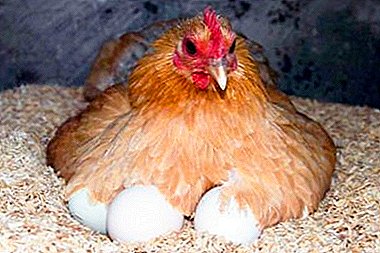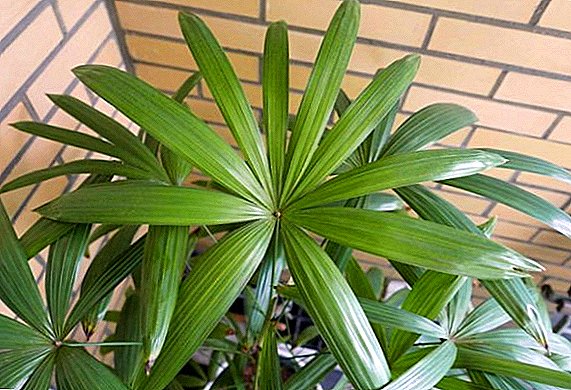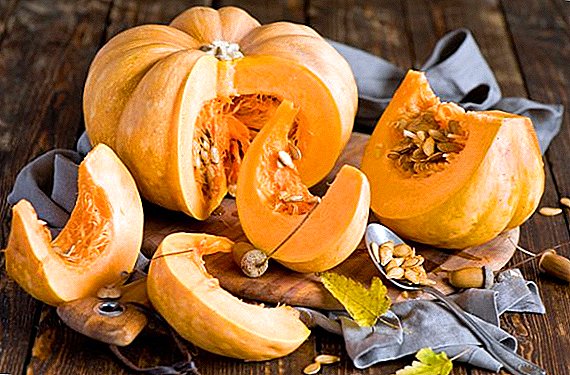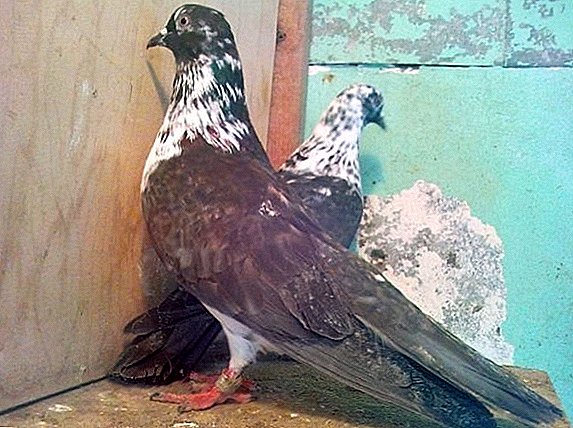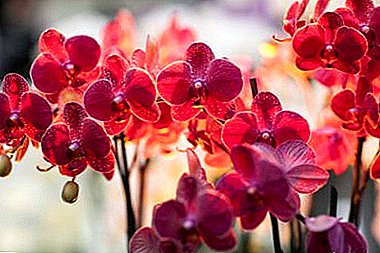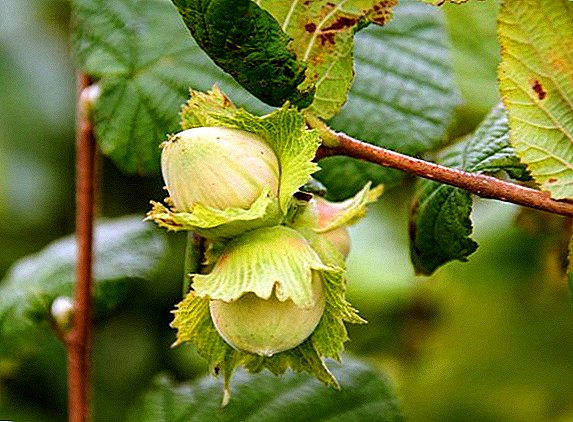 Hazel many people considered a mysterious tree, surrounded by legends, legends and superstitionsand. For example, the Slavs considered this plant to be pure and sacred, therefore during a thunderstorm they hid under it, stopped the branches by the belt and applied them to the place they wanted to protect from lightning. What is really remarkable this tree and how to grow it in the home, we describe below.
Hazel many people considered a mysterious tree, surrounded by legends, legends and superstitionsand. For example, the Slavs considered this plant to be pure and sacred, therefore during a thunderstorm they hid under it, stopped the branches by the belt and applied them to the place they wanted to protect from lightning. What is really remarkable this tree and how to grow it in the home, we describe below.
Hazel (Hazelnut): Description of Hazel
Hazel, or hazel - it is a deciduous tree (shrub) of the Birch family, growing to 10 meters. It has an egg-shaped, flat or spherical crown. The bark of the tree is gray-brown, dissected by transverse stripes. The root system is powerful, superficial. Hazel leaves are dull, dark green, pointed, rounded, ovate.
Did you know? The people call hazel hazelnut or a nut, and hazelnuts common in culture is a completely different plant. Hazelnuts and hazel - related trees, representatives of the same family.
 Hazelnut blossom (or as it is also called "hazelnuts") begins in early spring (March-April), even before the leaves bloom. During this period golden earrings appear on the tree. Since hazel refers to monoecious plants, both catkins and pistillate flowers are located on the same tree or shrub. Hazel flower consists of forked stamens. Hazel begins to bear fruit in the seventh or eighth year of life and produces crops annually. Fruits are small (2 cm), represented by oval or spherical nuts enclosed in a light green plyus. Each stem can contain up to 30 fruits, although it is usually found 3-4. Mature in August. Hazel tree reproduces by layering, seed, or root suckers.
Hazelnut blossom (or as it is also called "hazelnuts") begins in early spring (March-April), even before the leaves bloom. During this period golden earrings appear on the tree. Since hazel refers to monoecious plants, both catkins and pistillate flowers are located on the same tree or shrub. Hazel flower consists of forked stamens. Hazel begins to bear fruit in the seventh or eighth year of life and produces crops annually. Fruits are small (2 cm), represented by oval or spherical nuts enclosed in a light green plyus. Each stem can contain up to 30 fruits, although it is usually found 3-4. Mature in August. Hazel tree reproduces by layering, seed, or root suckers.
Today, there are more than 100 varieties of hazelnuts, the most popular of which is Panahesky. Its fruits have a pleasant taste and are characterized by a high fat content (62-65%). Moreover, this variety gives a bountiful harvest every year and does not need pollination.
Hazel lives in broadleaf, coniferous and mixed forests, and in those places where common hazel grows, it forms dense thickets, intensively growing on cuttings and pastures. Widely distributed in the Caucasus, the Middle East and in Europe. It prefers fresh, fertile and moist soil, therefore, it is usually found at the bottom of ravines, along rivers, streams, in the steppe and forest-steppe. On poor, marshy, acidic, peat soils practically does not grow.
However, tasty and healthy nuts can be tasted not only in the forests - this tree has been cultivated for a long time. Hazel harvest is quite possible to get on the backyards, if you know the details of care and cultivation of this plant.
Where is the best place to plant hazel
 Varieties of the described plant are various forms and interspecific hybrids of common hazelnut, Pontic, diverse leaf and large. Northeastern, eastern, northern parts of low slopes are preferable to cultivation in culture, since it is in these places that the fluctuations in daily temperatures are less and, consequently, the risk of burns and frostbite is lower.
Varieties of the described plant are various forms and interspecific hybrids of common hazelnut, Pontic, diverse leaf and large. Northeastern, eastern, northern parts of low slopes are preferable to cultivation in culture, since it is in these places that the fluctuations in daily temperatures are less and, consequently, the risk of burns and frostbite is lower.
Did you know? Hazelnut kernels contain up to 60% fat, 18% protein, vitamins, macro-and micronutrients, and due to their original taste, they are widely used in the food industry.
Choosing a landing site: how should the lighting be
Hazel -tIt is a tolerant tree and does not like direct sunlight, but with a strong darkening it can produce a bad crop, and its leaves change color. The place where hazel will grow should not be exposed to flooding.
Choose a free, moderately lighted territory and protected from drafts in the garden plot. In addition, the groundwater in the place where the plantation of hazelnuts is planned should not be above 1.5 meters.  An ideal place for planting - near the walls of buildings. If there is no such one, then a hedge can serve as protection from the winds. Growing hazelnuts is acceptable in the vicinity of trees with a voluminous crown, but they must be no closer than 4-5 meters from it. Thus, the optimal nutritional area of the hazelnut will be saved - 16-25 m².
An ideal place for planting - near the walls of buildings. If there is no such one, then a hedge can serve as protection from the winds. Growing hazelnuts is acceptable in the vicinity of trees with a voluminous crown, but they must be no closer than 4-5 meters from it. Thus, the optimal nutritional area of the hazelnut will be saved - 16-25 m².
Important! It is not recommended to plant hazel on the southern, drier slopes. Plants bloom there before, and there is a danger of frost damage to the ovary..
For the convenience of further care, it is recommended to plant hazel on a flat plot.
Soil requirements
In order to grow fruitful hazel on the plot, it is better to pick fertile, loose, well-drained, neutral or slightly acidic (pH 6-6.5) soil for planting. It is in this soil that hazelnuts quickly grow from the roots, it begins to bear fruit after 3-4 years, and the process of its cultivation does not create any unnecessary problems.
In chernozem soils, for better moisture and air permeability, it is recommended to apply sand and compost humus. Hazel will not survive well on sandy, rocky and marshy soil, and sour soil must be preliminarily lime (500 g per 1 m²).
Features planting garden hazel
 To obtain a bountiful harvest, you must first draw a pattern of planting hazelnuts, and you must take into account the fact that when you plant several trees alongside, natural cross-pollination is formed. It is best to plant hazel along the boundaries of the site.
To obtain a bountiful harvest, you must first draw a pattern of planting hazelnuts, and you must take into account the fact that when you plant several trees alongside, natural cross-pollination is formed. It is best to plant hazel along the boundaries of the site.
Selection of seedlings
Hazel breeds in several ways:
- Root shoots. Before transplanting in open ground, sprouts are grown in a greenhouse for 1-2 years. At the same time, all characteristics of the mother bush are preserved.
- Seeds. Planting of the fruit (namely, it is the seed) of hazel is made in spring or autumn. The bush begins to bear fruit in 5-6 years.
- By division. Branches that already have a root of 15 centimeters in length are separated from an adult plant. Each seedling is planted separately. With the help of such a seating arrangement it is possible to damage the thickets of hazel.
- Cuttings. To do this, take the strongest shoots no younger than 1-2 years.
- Layering. The branches in the spring bend to the ground, placed in the grooves and lightly added dropwise.
- Inoculation The procedure is carried out in the summer, and cuttings are harvested from the autumn.
Good hazel seedlings (if you plan to grow it as a cultivated plant) should have at least 2-4 lively twigs 30-50 cm long and 1-1.5 cm thick, and the root system should be well branched.
Did you know? Nutritionally, 400 g of hazel kernels are equivalent to a one-day adult diet.
Landing pit preparation
 Planting hazelnuts should be held in the fall. For a start, dig pits with a depth of 50-60 cm and a width of 80 cm, humus or compost (10-15 kg), mineral fertilizers (superphosphate, potassium sulfate) and rich soil taken from under the hazelnut are poured into them. The distance between the pits depends on the growth power of the variety. For example, for bush leaves it is necessary to have at least 4 meters, for standard boards - 1.5-2.5 meters. There is also planting with nests, in which several seedlings are placed in a circle around a large (about 1 m) hole, keeping the distance between seedlings at least 50 cm. big bush.
Planting hazelnuts should be held in the fall. For a start, dig pits with a depth of 50-60 cm and a width of 80 cm, humus or compost (10-15 kg), mineral fertilizers (superphosphate, potassium sulfate) and rich soil taken from under the hazelnut are poured into them. The distance between the pits depends on the growth power of the variety. For example, for bush leaves it is necessary to have at least 4 meters, for standard boards - 1.5-2.5 meters. There is also planting with nests, in which several seedlings are placed in a circle around a large (about 1 m) hole, keeping the distance between seedlings at least 50 cm. big bush.
Important! Allergy sufferers need to remember that hazel pollen causes allergic reactions.
Planting hazel in the garden
Before direct planting, the roots of seedlings are cut to 20-25 cm, wetted with a mash from a mixture of manure and clay, and then placed in prepared (not later than 2 weeks before planting) pits, at a distance of 4-5 meters from each other ( want to create a hedge). Green plantings must be poured abundantly (2 buckets for each sapling). After this, the near-trunk circles are mulched with a 3-5 cm layer of peat or humus, and the branches are shortened to 20-25 cm.
The level of the root of the neck should be buried by 2-3 cm and not cover the ground, which will stimulate the growth and branching of the roots. It is necessary to compact the soil only in the zone of spreading the roots. Since hazel needs cross-pollination, shrubs should be placed side by side, and it is better if they are of different varieties. The first time after planting hazelnuts, free space between the plants can be used for vegetable crops.
Did you know? Hazel bark has anti-inflammatory, antiseptic, astringent properties. Tincture of it helps with varicose veins, thrombophlebitis, prostate diseases, vitamin deficiency, malaria, hypertension, rickets.
All about hazelnut care
Usually, the care of young trees and bushes is reduced to loosening tree trunks and their mulching, but for hazelnuts there is a special technology of cultivation.
Watering and soil care
 Young seedlings need to start watering a week after planting. After 2-3 abundant irrigations, the capillaries of the soil will unite, the planting bed will not be separated from the rest of the soil and will retain its wet state, providing the seedling with the necessary elements for the next 3-4 years. If the year was dry, hazel need additional watering. Do not feel sorry for the water - the bushes need to be watered at least once a month. Remembering how the hazel and hazel grows and multiplies in natural conditions, it is necessary to take into account that they are prone to excessive formation of root shoots and, consequently, to lower yields. Therefore, root shoots need to be destroyed at an early age, as soon as they begin to rise above the surface. For effective removal, dig out the soil around each sprout and cut the sprout to the ground. This procedure is carried out in early spring.
Young seedlings need to start watering a week after planting. After 2-3 abundant irrigations, the capillaries of the soil will unite, the planting bed will not be separated from the rest of the soil and will retain its wet state, providing the seedling with the necessary elements for the next 3-4 years. If the year was dry, hazel need additional watering. Do not feel sorry for the water - the bushes need to be watered at least once a month. Remembering how the hazel and hazel grows and multiplies in natural conditions, it is necessary to take into account that they are prone to excessive formation of root shoots and, consequently, to lower yields. Therefore, root shoots need to be destroyed at an early age, as soon as they begin to rise above the surface. For effective removal, dig out the soil around each sprout and cut the sprout to the ground. This procedure is carried out in early spring.
Top dressing
In order for the hazelnut to bring a good harvest, not only proper planting is important, but also a certain care. In the autumn, hazel is fed with phosphorus and potassium, and in the spring the bush will need ammonium nitrate. In addition, in order for all fruits to ripen at the same time, they use nitrogen fertilizers - they are fed in July. Fruiting and young plants are well fed in the fall using organic fertilizers (manure, compost, superphosphate, potash salt) per 1 bucket per 1 m².
Important! Young seedlings need autumn soil mulching.
Pruning hazel garden
Hazel nut, planting and care for which is carried out at the dacha, as well as its wild relative, is capable of letting root shoots. In order to preserve the yield, you should not allow the thickening of the branches inside the bush (when forming the crown, only 6-10 of the most viable shoots are left that are not too close to each other).
 As the bush grows, twisting, damaged and dry branches are removed. Twenty-year-old plants are gradually replaced by young shoots, removing 2 “old men” a year.
As the bush grows, twisting, damaged and dry branches are removed. Twenty-year-old plants are gradually replaced by young shoots, removing 2 “old men” a year.
Hazel treatment for pests and diseases
It happens that common hazel begins to languish, although the landing and subsequent care were carried out in accordance with all requirements.
This is caused by the pests and diseases that so like the hazel:
- nut weevil;
- kidney mite;
- aphid;
- walnut barbel;
- shield;
- brown spot;
- powdery mildew.
Having found insects on a bush, it is necessary to shake them from the branches, previously spreading a film under the bush. Insecticides can also be used to control pests. They are processed twice per season: before bud break and after the appearance of leaves. For the treatment of diseases of hazel and hazel recommend the use of colloidal sulfur and boric acid.  If at the end of summer leaves are showered on hazelnuts in large quantities, the plant is most likely affected by the moths. They are either collected by hand or used to eliminate chemicals (in case of excessive contamination). As a preventive measure for the appearance of pests in the spring, the bark of the bush should be cleaned in time, the foliage collected in the fall should be cleaned, and during the summer also wormy fruits should be removed.
If at the end of summer leaves are showered on hazelnuts in large quantities, the plant is most likely affected by the moths. They are either collected by hand or used to eliminate chemicals (in case of excessive contamination). As a preventive measure for the appearance of pests in the spring, the bark of the bush should be cleaned in time, the foliage collected in the fall should be cleaned, and during the summer also wormy fruits should be removed.
Did you know? To increase the fat content of breast milk Hazel kernels are recommended to use during lactation.
Harvesting
Hazel harvest ripens in August and early September. A mature nut is distinguished by a brownish ply, which on fully ripened fruit opens slightly and begins to crumble. The harvest is dried for 2-3 weeks, which makes it easier to separate the kernels from the pluses. Collected fruits are stored in fabric or paper bags in a dry place - then they do not lose their taste in two years.
Important! The poorly dried fruits of hazel are quickly becoming moldy.
 Any beautiful shrubs can be used for decorative purposes, so the presence of a "forest dweller" on the site has become an affordable option for landscaping. You just need to know what hazel is, choose the right variety, correctly plant and adhere to the rules of further care.
Any beautiful shrubs can be used for decorative purposes, so the presence of a "forest dweller" on the site has become an affordable option for landscaping. You just need to know what hazel is, choose the right variety, correctly plant and adhere to the rules of further care.


